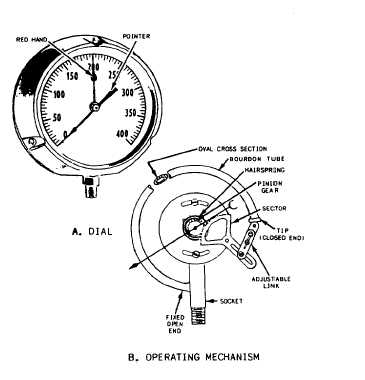CHAPTER 8
MEASUREMENT AND PRESSURE
CONTROL DEVICES
For safe and efficient operation, fluid power
systems are designed to operate at a specific
pressure and/or temperature, or within a pressure
and/or temperature range.
You have learned that the lubricating power
of hydraulic fluids varies with temperature and
that excessively high temperatures reduce the life
of hydraulic fluids. Additionally, you have
learned that the materials, dimensions, and
method of fabrication of fluid power components
limit the pressure and temperature at which a
system operates. You have also learned of means
of automatically controlling pressure in both
hydraulic and pneumatic systems.
Most fluid power systems are provided with
pressure gauges and thermometers for measuring
and indicating the pressure and/or the tempera-
ture in the system. Additionally, various tempera-
ture and pressure switches are used to warn of an
adverse pressure or temperature condition. Some
switches will even shut the system off when an
adverse condition occurs. These devices will be
discussed in this chapter.
PRESSURE GAUGES
Many pressure-measuring instruments are
called gauges. However, this section will be
restricted to two mechanical instruments that
contain elastic elements that respond to pressures
found in fluid power systems—the Bourdon-tube
and bellows gauges.
BOURDON TUBE GAUGES
The majority of pressure gauges in use have
a Bourdon-tube as a measuring element. (The
gauge is named for its inventor, Eugene Bourdon,
a French engineer.) The Bourdon tube is a device
that senses pressure and converts the pressure to
displacement. Since the Bourdon-tube displace-
ment is a function of the pressure applied, it may
be mechanically amplified and indicated by a
pointer. Thus, the pointer position indirectly
indicates pressure.
The Bourdon-tube gauge is available in
various tube shapes: curved or C-shaped, helical,
and spiral. The size, shape, and material of the
tube depend on the pressure range and the type
of gauge desired. Low-pressure Bourdon tubes
(pressures up to 2000 psi) are often made of
phosphor bronze. High-pressure Bourdon tubes
(pressures above 2000 psi) are made of stainless
steel or other high-strength materials. High-
pressure Bourdon tubes tend to have more circular
cross sections than their lower-range counterparts,
which tend to have oval cross sections. The
Bourdon tube most commonly used is the
C-shaped metal tube that is sealed at one end and
open at the other (fig. 8-1).
Figure 8-1.—Simplex Bourdon-tube pressure gauge.
8-1


